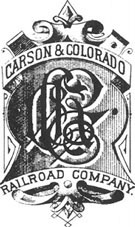Candelaria
Although silver was first discovered here in 1863 by Spanish prospectors, the area wouldn't see much development until 1873 when the Northern Belle mine opened. Within two years, the Columbus district became one of Nevada's most productive. In 1875 and 1876, mills were erected in Belleville and in August 1876 the town of Candelaria was platted.
Candelaria's first post office (spelled Candelara) opened August 18, 1876 and within the next month the town boasted two hotels, eleven saloons, testaurants, livery stables, and several other businesses. Freight was hauled to Wadsworth, 120 miles away, by way of the Wadsworth-Columbus Freight Route. As a result, manufactured goods were expensive.
From 1876 and well into the 1880s, the Northern Belle averaged $1 million in production each year. In 1880, Candelaria was recorded as the largest town in Esmeralda County and from 1881-83 the mines peaked. The town of 1500 was home to a bank, telegraph office, school, lumber companies, stores, two breweries, three doctors, lawyers, and over twenty-four saloons. A newspaper, the True Fissure, ran from 1880-1886. On November 23, 1882, the post office gained the 'i', officially becoming Candelaria.
Just above Candelaria in Pickhandle Gulch, another small camp formed in 1876. Known originally as Pickhandle Gulch, the camp was renamed Metallic City, or just Metallic, in 1879. Metallic held its own post office from January 4, 1880 to July 7, 1881 and during its tenure reached a population of 300 and had a decent business district of its own.
In February 1882, the Carson & Colorado Railroad's first trained pulled into Candelaria and it seemed that the town would remain prosperous. Unfortunately, a fire in 1883 destroyed part of town. In 1884, amidst legal problems, the Northern Belle and Holmes mines were consolidated, and in 1885 production dropped 50% as a result of a summer-long strike. Candelaria's decline was on the horizon.
The camp saw a revival in 1890, enough so to support another newspaper, the Chloride Belt. This lasted until 1892, when after over $20 million had been removed, Candelaria faded. Small revivals continued into the 20th Century, and in 1919 the Candelaria Mines Company consolidated the most important mines. Candelaria finally lost its post office on January 31, 1939. Throughout the later part of the 20th Century, a large open pit mine was operated at the site, closing in 1999. These operations spared the Candelaria townsite, but obliterated Metallic City and the surrounding mines. For years, impressive stone ruins remained of the Esmeralda Bank building and the Tarpey Store, but they were devastated by a 6.5 earthquake centered just 12 miles away on May 15, 2020.























